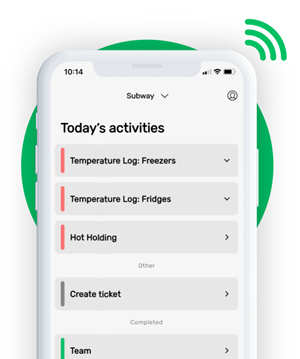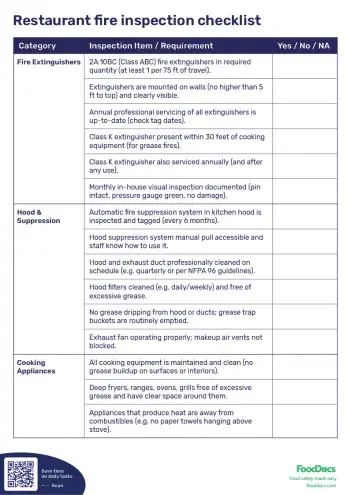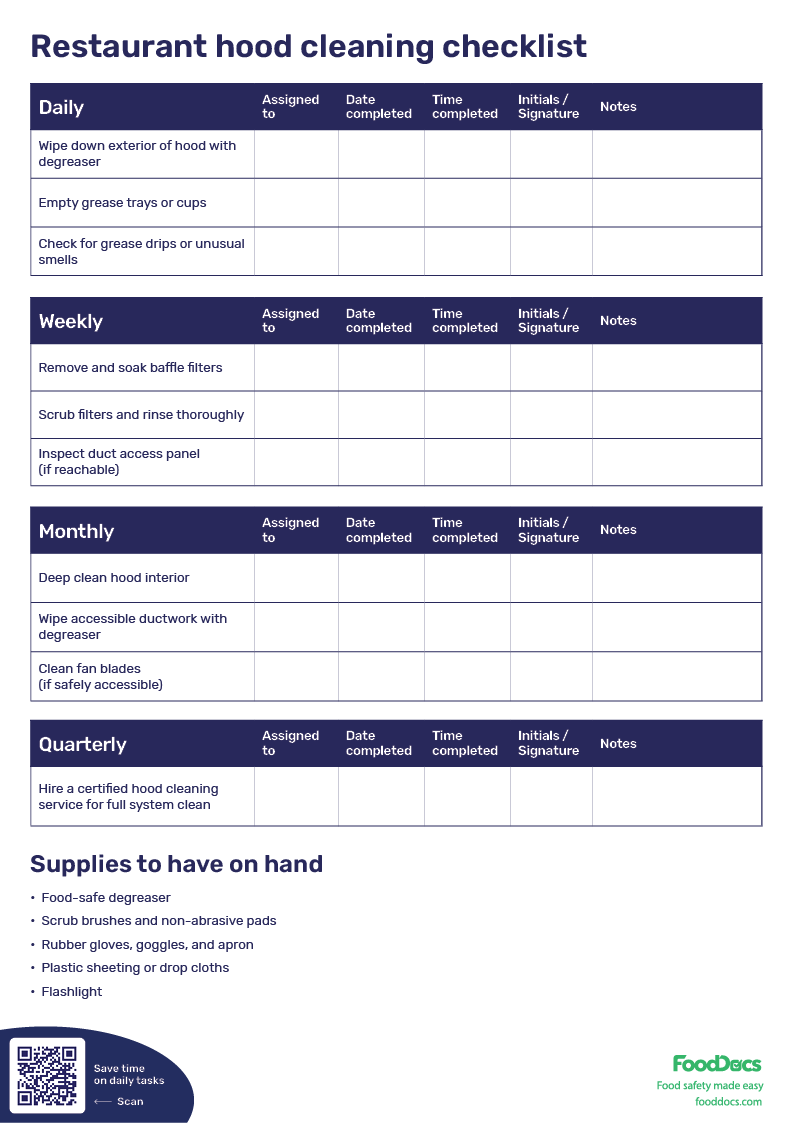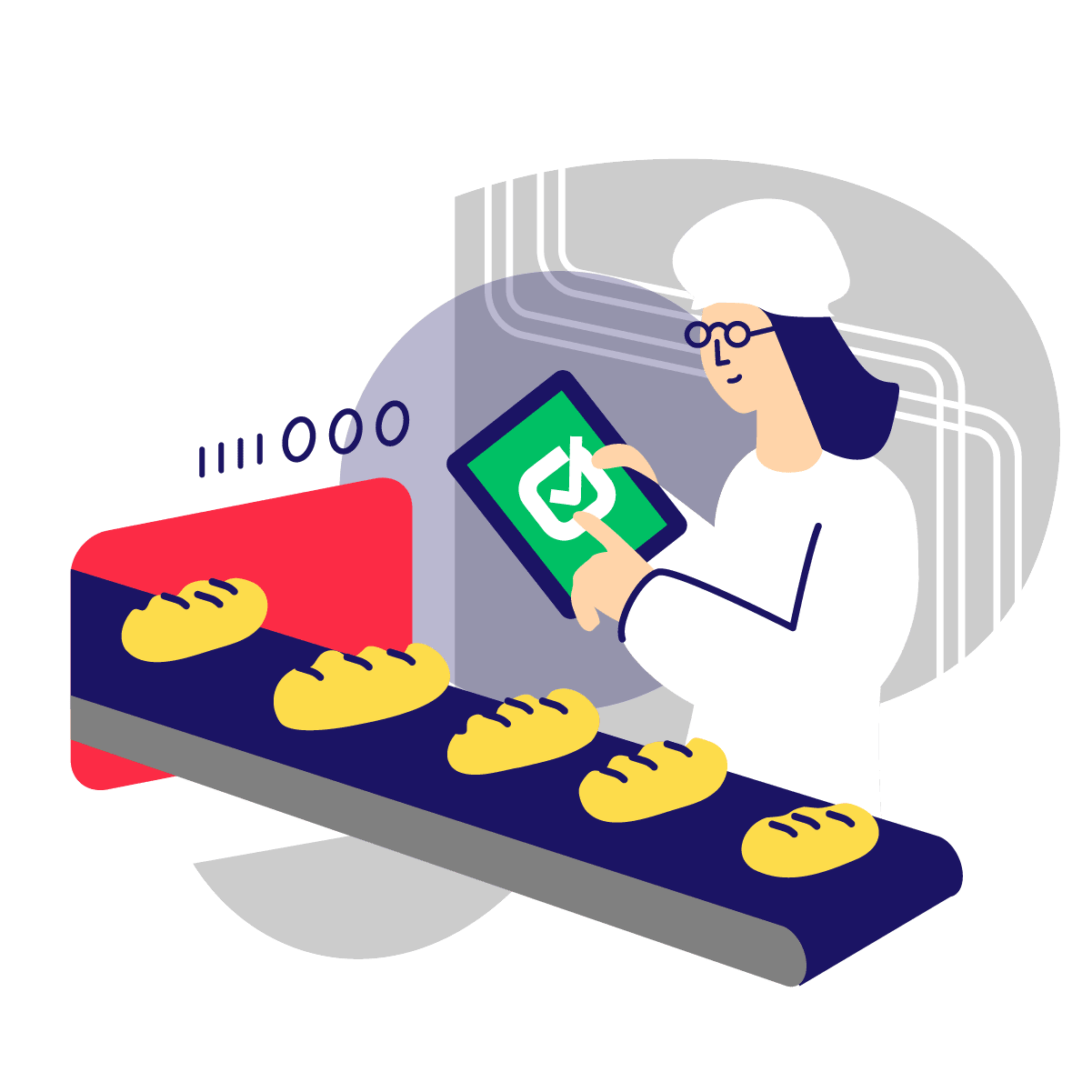RESTAURANT KITCHEN HOOD CLEANING | HOW-TO GUIDE AND FREE POSTER
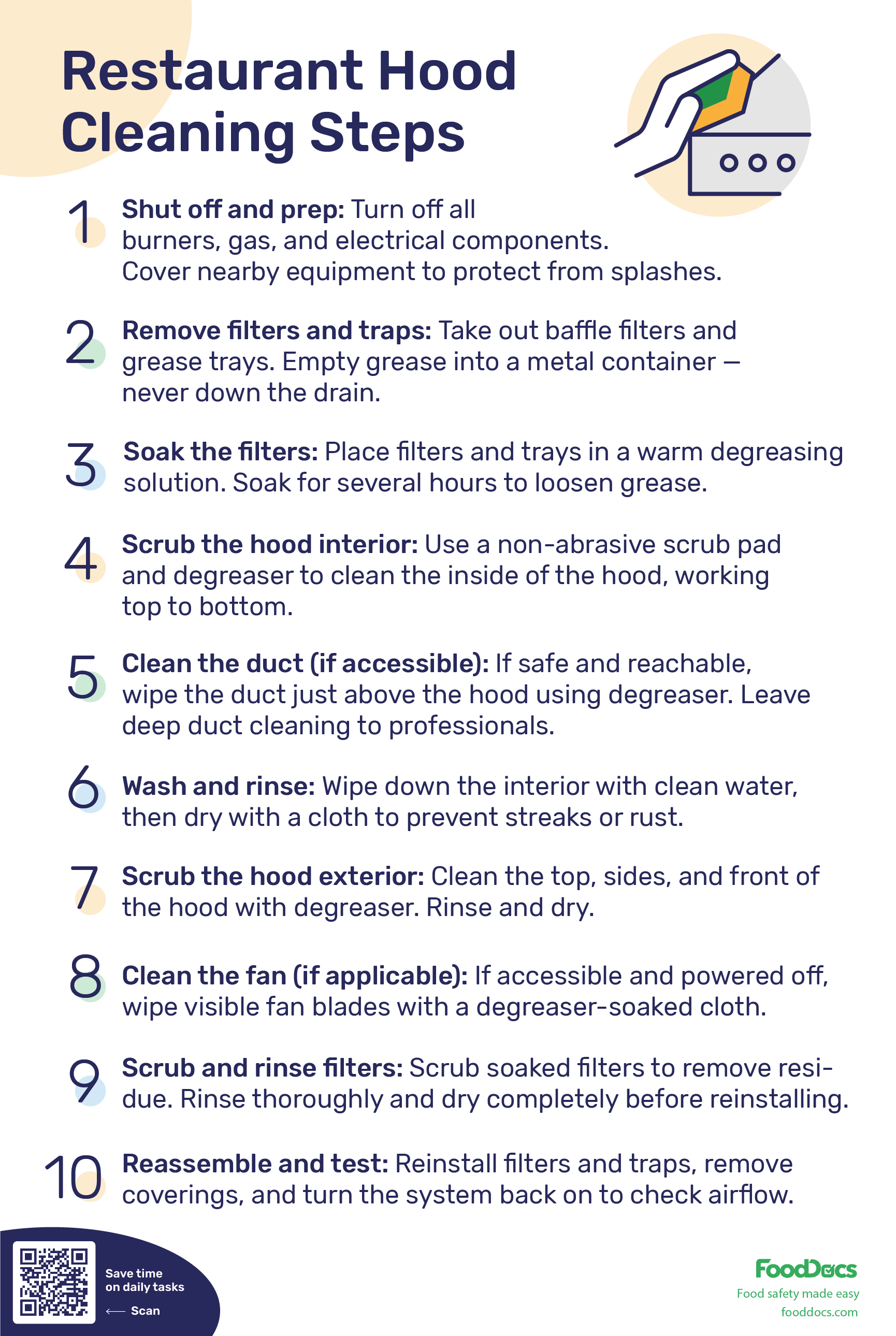

This is how our Digital Food Safety platform saves 20% of your time on daily tasks:
- Get upcoming task notifications
- Add data into the app
- Check the status of tasks in real-time

When food safety was still handled on paper, I typically spent a couple of hours per day getting the papers and going around checking or completing tasks… Now I can sit down and it's just all there in one place. It takes me 5-10 minutes.
Ruth B.
Store Manager
Grease builds up quickly in a busy commercial kitchen hood, creating a serious fire hazard and hindering ventilation. Over 20% of restaurant fires are linked to dirty hoods and ducts that weren’t cleaned on time.
A grease-laden exhaust hood not only traps heat and smoke, but provides fuel for flames. Regular kitchen exhaust hood cleaning is so crucial that it’s mandated by fire safety codes and health departments.
Key takeaways
-
Grease buildup in kitchen hoods is a major fire risk, making regular cleaning a safety and compliance essential.
-
NFPA 96 sets the cleaning frequency based on cooking volume, with most restaurants needing professional service at least twice a year.
-
A complete cleaning includes the hood, filters, ducts, and exhaust fan, not just what’s visible.
-
Manual cleaning works for light-duty tasks, but certified professionals are required to clean the full exhaust system safely and legally.
-
Inspectors look for grease levels, access points, and cleaning records, so keeping detailed logs and certificates is key.
-
Avoid common mistakes like using the wrong tools, skipping the ducts, or cleaning too infrequently, as they can lead to shutdowns or fires.
-
Hood cleaning costs range from $200 to over $3,000, depending on system size and grease buildup.
-
Choosing the right hood cleaning company means verifying they clean ducts and fans, provide documentation, and follow NFPA standards.
-
Checklists with assigned roles, frequencies, and supervisor sign-offs help ensure cleaning tasks are done correctly and consistently.
-
FoodDocs helps automate reminders, task tracking, and digital logs, making it easier to stay compliant and inspection-ready.
Why does regular restaurant hood cleaning matter?
Simply put, regular restaurant hood cleaning matters because it keeps your kitchen hood clean and protects your staff, customers, and business. Beyond fire prevention, a clean hood maintains good air quality. It pulls out smoke, odors, and grease vapors effectively when it’s not clogged.
This makes the kitchen safer and more comfortable for your back-of-house team. It also keeps the cooking area up to code.
Failing to clean hoods on schedule can lead to hefty fines or even closures if inspectors find excessive grease buildup. No chef or food safety leader wants an avoidable violation on their record.
Get your free restaurant fire inspection checklist
How often should restaurant hoods be cleaned?
Many kitchen owners ask, “How often should restaurant hoods be cleaned?” The answer depends on your cooking volume and methods. Fire codes such as the National Fire Protection Association (NFPA) 96 set inspection schedules based on operation type, which in practice translate to cleaning frequencies:
- Monthly: for solid-fuel cooking (wood or charcoal grills)
- Quarterly (every 3 months): for high-volume kitchens (24/7 operations, charbroiling, wok cooking)
- Semiannually (every 6 months): for moderate-volume cooking (most restaurants)
- Annually: for low-volume or seasonal cooking (church kitchens, shelters, etc.)
These are minimum guidelines for commercial kitchen exhaust hood cleaning. Heavy-use establishments often need cleanings even more frequently. The best rule is to clean as soon as grease has noticeably accumulated, even if that means every month or every couple of weeks in an extremely busy kitchen.
Skipping or delaying a needed cleaning just isn’t worth the risk. Fire marshals can and will shut down a restaurant if a required hood cleaning is overdue.

In addition to the exhaust hood itself, remember to clean or swap out the grease filters much more often. Many kitchens run filter cartridges through the dishwasher or degrease them weekly.
Staying on top of filter cleaning helps prevent grease from reaching deeper into the ductwork. It’s a simple task that dramatically reduces fire danger and keeps the whole exhaust system running efficiently.
How to clean a commercial kitchen hood (step-by-step)
Tackling a commercial kitchen hood cleaning can be messy, so proper preparation is key. Always schedule this job for when the kitchen is cool and idle (e.g., after restaurant closing). Wear rubber gloves, goggles, and an apron to protect yourself from caustic degreaser and dripping grease.
This video is a great 9-minute primer on how to clean a kitchen exhaust hood. The lead technician, Dustin, walks you through his process on how to clean a kitchen exhaust hood from start to finish, going through spraying the chemical, rinsing with pressure, squeegeeing the hood, and finishing with drying and shining.
They've also got a great commercial kitchen exhaust cleaning tutorial, start to finish (part 1 and part 2) if you've got an hour to spare.
If you're kitchen team is in maintenance mode and can handle some of simpler restaurant hood cleaning tasks, here’s a 10-step guide:
- Shut off and prep: Turn off all stove burners, gas valves, and electrical components under the hood. Make sure everything is cooled down. Cover nearby kitchen equipment and surfaces with plastic sheeting or drop cloths. This prevents contamination from cleaning chemicals and greasy water from splattering on appliances or food areas.
- Remove filters and traps: Most hoods have removable baffle filters (metal grease filters) and grease drip trays or cups. Take these out carefully and set them aside. This gives you access to the interior of the hood. If your system has grease catch trays, empty them into a metal container. Never pour grease down a drain.
- Soak the filters: In a large sink or tub, mix a degreasing solution of warm water and a commercial kitchen degreaser. Check the product label for the correct water-to-degreaser ratio. Place the metal filters and grease drip parts into this solution to soak. For heavy grease, let them soak 2–3 hours or even overnight to loosen the buildup.
- Scrub the hood interior: Using a non-abrasive scrub pad or soft-bristle brush, scrub the inside of the hood canopy with the same degreasing solution. Work from the back and top down, as grease will drip downward. Apply firm pressure to remove grease deposits, but avoid scratching the stainless steel. Take your time to get into the corners and seams where grime accumulates. You want to remove all visible grease from the stainless surfaces inside the hood.
- Clean the duct (if accessible): Many hoods have access panels into the ductwork. If you can reach into the duct immediately above the hood, wipe it out with degreaser as far as you safely can. Never climb into a duct or dismantle it on your own. Deeper duct and fan cleaning is usually a job for professionals with special tools. But wiping the accessible section just above the hood can help. Modern codes require access doors in ducts and hinge kits on fans to allow easier cleaning, but if yours is not readily reachable, don’t take risks beyond your comfort level.
- Wash and rinse: Once the interior is scrubbed, use a clean cloth dipped in warm water to wipe down all the same surfaces, removing any leftover degreaser and dissolved grime. Change the rinse water frequently. Then do a final wipe with a dry cloth or paper towels to leave the metal surfaces clean and dry. Moisture left behind can lead to streaks or rust.
- Scrub the hood exterior: Grease and dust also collect on the outside of the hood canopy. Using your degreaser solution, gently scrub the exterior top, sides, and front of the hood. This keeps the hood looking sharp and prevents grease from creeping into seams. Rinse and dry the outside as well.
- Clean the fan (if applicable): If you have easy access to the exhaust fan blades (for example, some rooftop fans can be opened via a hinge), you can carefully wipe the fan blades with a degreaser-soaked cloth. Make sure the power to the fan is off and the fan is locked out before doing this. In many cases, full fan cleaning is done by professionals using steam or pressure washers, but at least clear off any visible grease on accessible parts.
- Scrub and rinse filters: By now, your baffle filters have soaked, and the grease has softened. Take each filter out of the soak, scrub it with a brush to remove remaining residue, and rinse it thoroughly with hot water. Inspect each filter by holding it up to the light – it should be free of grease and allow light through. Let the filters air dry completely (or dry with clean towels) before reinstalling them.
- Reassemble and test: Put the clean, dry filters and grease traps back into the hood. Remove the plastic coverings from the equipment and wipe down any overspray in the area. Turn your exhaust fan back on and do a quick test while observing the hood. The air flow should be strong, with no drips of water.
Congratulations — your kitchen hood cleaning is complete!

Note: If this process sounds labor-intensive, that’s because it is. Manual scrubbing is very effective at degreasing a hood, but it requires significant time and elbow grease. Alternatives like power washing or steam cleaning can speed up cleaning large hoods or stubborn grease.
Just be aware that pressure washing can be messy and typically must be done by trained personnel to avoid damaging equipment. Some restaurants even invest in automated hood cleaning systems that spray cleanser on a schedule, though these are specialized solutions.
For most kitchens, a thorough manual cleaning by staff or a hood cleaning service is the go-to method.
What should be on a restaurant hood cleaning checklist?
Need something you can print or post on the wall? Here’s a basic checklist you can use for quick reference to make sure your hood cleaning routine stays on track.
Get a free restaurant hood cleaning checklist
with detailed step-by-step instructions
Daily
- Wipe down exterior of hood with degreaser
- Empty grease trays or cups
- Check for grease drips or unusual smells
Weekly
- Remove and soak baffle filters
- Scrub filters and rinse thoroughly
- Inspect duct access panel (if reachable)
Monthly
- Deep clean hood interior
- Wipe accessible ductwork with degreaser
- Clean fan blades (if safely accessible)
Quarterly
- Hire a certified hood cleaning service for full system clean
Supplies to have on hand
- Food-safe degreaser
- Scrub brushes and non-abrasive pads
- Rubber gloves, goggles, and apron
- Plastic sheeting or drop cloths
- Flashlight
If you're using a tool like FoodDocs, you can digitize this checklist and assign each task to the right team member. That way, nothing falls through the cracks.

What not to do when cleaning your restaurant kitchen hood
Knowing what not to do is just as important as knowing what to do. Here are some common mistakes to avoid when cleaning your restaurant hood:
- Don’t postpone cleanings: Never wait too long between hood cleanings. Delaying will lead to very heavy grease buildup that becomes much harder to remove. Worse, built-up grease in the hood, ducts, and fan is a ticking time bomb for a flash fire. Stick to a regular restaurant cleaning schedule so you’re never far past due.
- Don’t rely on DIY alone for deep cleans: While daily or weekly filter cleaning can be done in-house, do not assume that an untrained staff member can thoroughly degrease the entire exhaust system. Professional cleaning is required by fire code for a reason. If you lack proper tools or knowledge, you might miss critical areas. Never attempt major duct or fan cleaning without training. You could injure yourself or damage the equipment.
- Don’t use improper chemicals or tools: Avoid any cleaning chemicals that aren’t meant for kitchen use. For example, never mix degreasers with bleach or use flammable solvents on a grease hood. This can lead to chemical contamination. Use a food-safe degreaser as directed. Also, don’t use metal scrapers or steel wool on the hood, as they can scratch the steel and remove protective coatings. Stick to plastic scrapers or nylon pads for tough residue.
- Don’t settle for partial cleaning: If you hire a kitchen hood cleaning service, make sure they clean the entire exhaust system, not just the visible hood and filters. Some less-qualified outfits only wipe the hood interior and call it a day. Grease hidden in ducts or on fans will remain a fire hazard. Only certified cleaners know how to properly clean the whole system, top to bottom. It’s worth the investment to do it right.
- Don’t ignore routine inspections: Even between scheduled professional cleanings, keep an eye on your hood system. Check grease buildup levels on filters, inside the hood, and around the fan periodically. If you notice unusual smoke or odors, it may indicate that the hood or ducts need attention sooner. And when you do get a professional cleaning, always review the service report or sticker. Reputable companies provide before-and-after photos and details of what was cleaned. If something seems skipped, follow up immediately.
Avoiding these mistakes will prolong the life of your equipment and maintain a safer kitchen. A little diligence and the right approach go a long way in commercial kitchen hood cleaning.
What do inspectors look for during restaurant hood system checks?
When fire inspectors or health officials walk through your kitchen, they don’t just eyeball the floors. The hood system is one of the first things they check. Here’s what they’re looking for.
- Grease buildup inside the hood or dripping from filters
- Proper cleaning frequency based on your cooking volume
- Filter condition (clean, intact, securely mounted)
- Certification stickers from your most recent professional cleaning
- Access panels on ductwork and rooftop fans
- Fan hinge kits (required in many jurisdictions)
- Fire suppression system tags (up to date and not expired)
Inspectors have walked into kitchens and found filters covered in grease, access panels rusted shut, and no proof of the last cleaning. That’s a quick way to get cited or shut down. If you can show your cleaning log, last service date, and that everything looks clean and maintained, you’re off to a strong start.
6 Extra fire safety tips beyond cleaning
Keeping the hood clean is one part of fire prevention. These habits make your kitchen even safer.
- Always run the exhaust fan while cooking
- Store paper towels, oils, and flammables away from cooking equipment
- Never cook with missing or clogged filters
- Make sure staff know how to use a Class K fire extinguisher
- Check suppression system tags regularly
- Train new hires on grease fire protocols during onboarding
A clean hood system helps, but these daily habits are what keep things safe between cleanings.
What are the certification and cost requirements for professional restaurant hood cleaning services?
Cleaning an entire exhaust system (hood, filters, ducts, and exhaust fan) is a big job. That’s why most restaurants periodically hire a commercial kitchen hood cleaning service that specializes in this work.
These professionals come equipped with pressure washers, steam cleaners, and the expertise to dismantle and degrease every component of your exhaust system. Typically, they’ll schedule the job overnight or during downtime, because the process can shut down your kitchen for several hours.
They prep the area with plastic sheeting, protect your appliances, and use hot water pressure washers to blast away grime from the hood to the rooftop fan. By morning, your system is clean and ready.
Do you have to be certified to clean restaurant hoods?
In most cases, yes, you have to be certified to clean restaurant hoods. Fire codes usually require that hood cleanings (and the accompanying inspections) be done by technicians who are properly trained and certified in kitchen exhaust cleaning.
Most cities even insist that a valid certificate or proof of cleaning be kept on-site to show the fire inspector. This means your staff can certainly do interim cleaning for maintenance, but the official cleanings that satisfy insurance and code requirements should be done by a certified professional.
These pros know the NFPA 96 standards inside out and will ensure your commercial kitchen exhaust hood cleaning meets all legal requirements. After a professional service, you’ll receive a certificate or sticker documenting the date and scope of cleaning – file this safely in your records.
How much does it cost to clean restaurant hoods?
The price for professional hood cleaning can vary with the size of your system and how dirty it is. For a:
- Small restaurant with one or two hoods, a routine cleaning might cost around $200 to $500 per visit.
- Medium-sized restaurants with multiple hoods and ducts might pay between $800 and $1,500 for a deeper cleaning of the whole restaurant system.
- Large or high-volume operations (think big hotels or huge fast-casual kitchens) often range from $1,500 up to $3,000 per cleaning.
In extreme cases like an enormous kitchen with several hoods or a long-neglected system, costs could reach $5,000 or more for an intensive cleaning and component overhaul. Most typical restaurants fall in the few-hundred-dollars range for a standard service.
Keep in mind, these cleanings usually happen a few times a year, so budget accordingly. Many businesses schedule quarterly or semiannual cleanings, which helps spread out the expense and keeps the kitchen safe.
While hiring pros is an investment, it pays off in safety and peace of mind. One restaurant diner owner in Florida, Amy Tallard, learned this the hard way after trying to let staff handle the hood cleaning, she experienced a major grease fire that caused extensive damage. Now, she brings in professional cleaners every 6 weeks to clean the entire system and never risks another fire. The moral: proper hood cleaning is well worth it, and skimping on it can cost far more in the long run.
Manual, professional, or automated: Which hood cleaning method fits you?
There’s more than one way to clean a kitchen hood. Each method comes with its upsides and downsides. Use this chart to compare, then read below to see which might work best for your operation.

So, how do you decide?
- Manual cleaning is best for small kitchens with low to moderate grease output. If you’ve got a trained team and a straightforward system, this can be cost-effective. Just make sure someone owns the task and does it right.
- Professional cleaning is essential for most restaurants, especially if you serve high volumes or have multiple hoods. This is the safest way to stay compliant with fire codes and pass inspections.
- Automated systems make sense in large or 24/7 kitchens where downtime is tricky. These systems spray degreaser on a schedule and reduce the need for manual labor. They’re pricey upfront, but can save time and labor in the long run.
Some restaurants do a mix. For example, they clean filters and hoods weekly and hire pros every 3 months. Whatever your method, the key is consistency.
How to choose a reliable hood cleaning company
Not all hood cleaners are equal. Some companies only wipe down the visible parts and leave the dangerous grease inside the ducts untouched. Here’s how to find a crew that actually knows what they’re doing and does it right.
- Ask if they follow NFPA 96 guidelines: This is the national fire code standard for kitchen exhaust systems. If a company follows NFPA 96, it means they’ll clean your entire system from the hood to the rooftop fan, not just the easy-to-reach parts. It also shows they understand what inspectors look for.
- Check for certifications or technician training: Certified technicians have been trained to clean kitchen exhaust systems safely and thoroughly. You can also ask if they belong to industry groups like IKECA (International Kitchen Exhaust Cleaning Association), which sets professional standards for cleaning companies.
- Request before-and-after photos: Good companies document their work with photos so you can see exactly what they cleaned. This is helpful not just for peace of mind, but also for fire inspectors and insurance claims. If a company doesn’t offer this, that’s a red flag.
- Make sure they clean the ductwork and fan: Some cheaper services only wipe down the hood canopy and skip the fan and ducts. But grease in those hidden spots is the most dangerous. Ask how they access and clean the full system, and whether they open panels or use rooftop access.
- Ask if they install fan hinges or access doors: If your fan doesn’t have a hinge or your duct doesn’t have a clean-out panel, they won’t be able to clean it properly. A good service will point this out and offer to install the hardware so your system meets code.
- Get a written report or sticker: Reputable services leave a dated sticker on the hood and provide a report outlining what was cleaned. Keep that report in your food safety log. It’s the first thing an inspector will ask to see.
Bottom line: If the service is vague, underpriced, or unwilling to explain their process, you’re probably not getting a full clean. Always go with a certified, transparent provider who takes safety seriously.
How can kitchen teams stay organized with cleaning checklists and maintenance logs?
Maintaining a clean and safe kitchen isn’t a one-time project – it requires continuous effort and organization. This is where cleaning checklists and maintenance logs become a chef’s best friend. Using a structured checklist will help ensure that daily, weekly, and monthly cleaning tasks (e.g., wiping down equipment, cleaning grease traps, and yes, degreasing the hood and filters) are never forgotten.
For example, a restaurant deep cleaning checklist can specify that exhaust hoods and vents be cleaned every month, and filters be changed or cleaned on schedule. Breaking tasks down by frequency and area helps your team stay on top of everything without feeling overwhelmed.
Consider creating a dedicated hood cleaning log as part of your kitchen’s maintenance records. Each time the hood or exhaust system is cleaned by your staff or an outside service, log the date, what was done, and who did it.
Keeping a maintenance log in this way serves two purposes:
- Ensures accountability that the cleaning happened
- Provides documentation to authorities or insurance if needed
Health inspectors and fire marshals love to see detailed records. If you can show an inspector a log entry proving the hood was professionally cleaned last month, it builds confidence that you run a tight ship. Many restaurants even keep the latest cleaning certificate on file next to a log sheet for easy reference.
To help with this, you can use ready-made tools like cleaning schedule templates or digital apps. For instance, FoodDocs offers a free restaurant cleaning checklist template that you can download and customize to your needs. Adopting such templates makes it easier to list out all tasks (from scrubbing the hood to mopping the floors) and assign them to your team with appropriate frequency.
The key is to make cleaning routines systematic. When everyone knows their duties and checks them off in a log or checklist, nothing important (e.g., monthly hood degreasing) will slip through the cracks.
Ready to embrace digital restaurant checklists with FoodDocs?
Tracking deep cleaning and food safety tasks by hand can get messy. FoodDocs' restaurant food safety software makes it simple. You can digitize your cleaning checklists, set reminders, and keep everything organized in one place.
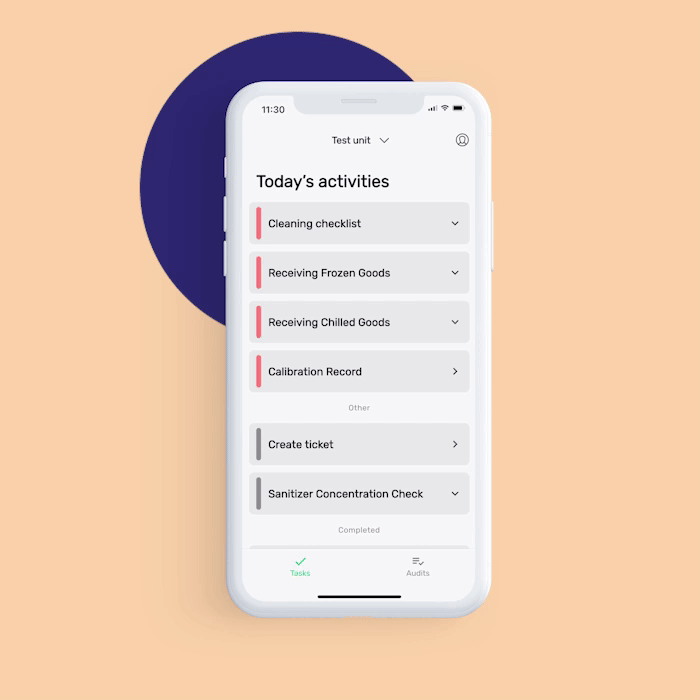
For example, set a recurring task to clean hood filters every Wednesday or schedule quarterly reminders for your hood cleaning service. You can get set up fast and try it out with a 14-day free trial!
Each task can include step-by-step instructions so your team knows exactly what to do. When it’s done, they check it off in real time. Managers can see progress at a glance, even if they’re not on-site.

Best of all, FoodDocs keeps a digital monitoring log for everything. So if an inspector asks for proof of your last exhaust hood cleaning, it’s right there, no paperwork shuffle required.
With tools like this, staying clean and compliant becomes part of your kitchen’s routine. It saves time, cuts stress, and helps your team stay ready for anything.
Keeping your restaurant’s hood clean is an ongoing responsibility, but with the right approach, it becomes part of your kitchen’s rhythm. Stick to a cleaning schedule, know when to bring in the pros, and use tools like checklists (or better yet, FoodDocs’ digital checklists) to stay organized.
Your reward will be a safer kitchen, better air quality, and the confidence that you’re protecting your team and guests every day.
What top questions do people ask about restaurant hood cleaning?
What is a restaurant kitchen hood?
A kitchen hood, also known as an exhaust hood or range hood, is a device mounted above cooking equipment in commercial kitchens. It uses a fan and filters to remove smoke, grease, heat, and odors from the air
How does a commercial restaurant hood work?
A commercial restaurant hood works with four key components:
- Filters catch grease before it reaches the fan.
- Fans pull the air up and out through ducts.
- Grease traps collect drips to prevent buildup.
- Ductwork channels the filtered air outside
What happens if you don’t clean the hood properly?
Neglected hoods accumulate grease in ducts and fans, increasing fire risk and raising the chance of failed inspections. In extreme cases, authorities may close the kitchen until it’s serviced.
Can I clean a restaurant hood fan myself?
Only accessible parts of the fan should be cleaned by staff. Deep cleaning of fan blades or duct interiors requires professional tools and certification. DIY deep cleans risk injury or damage to equipment.
What documentation should I keep after a kitchen hood cleaning?
Keep the technician’s cleaning report, dated sticker, before-and-after photos, and notes in a maintenance log. These documents prove safety compliance during inspections and protect your liability.
